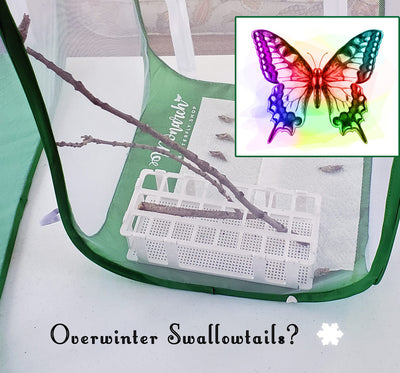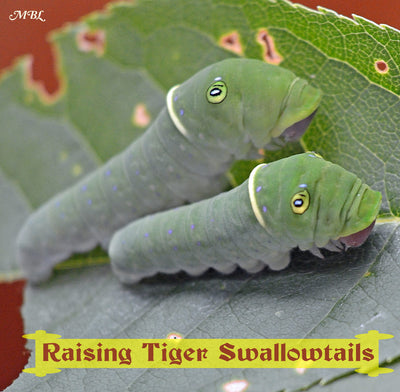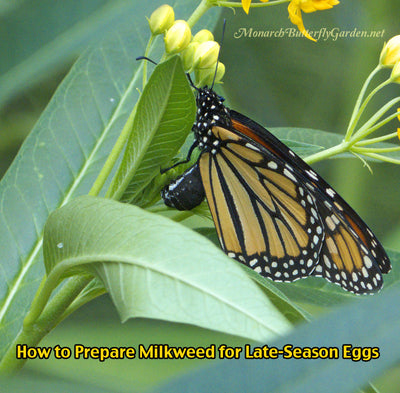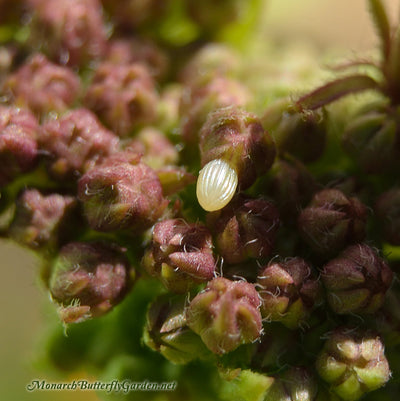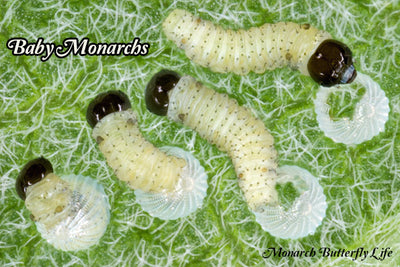Raising Butterflies Blog
Five Instar Stages of the Monarch Caterpillar Life Cycle

The monarch butterfly life cycle is divided into 4 main stages: egg, caterpillars, chrysalis, and butterfly.
Since Caterpillars grow approximately 2000% during this larval stage of monarch metamorphosis, the caterpillar life cycle phase is subdivided into 5 stages, known as instars.
1st Instar Monarch Caterpillar
2nd Instar Monarch Caterpillar
3rd Instar Monarch Caterpillar
4th Instar Monarch Caterpillar
5th Instar Monarch Caterpillar
The measurements listed below are rough estimates of caterpillar instar sizes but larvae will vary in size depending on genetics, and how much milkweed they eat.
Instar 1 Monarch Caterpillar Body Length- 2mm to 6mm (<.2 inches)

The hatchling first emerges, only to turn back around to devour its nutrition-laced eggshell, or chorion. Soon after, it will feed in a circular pattern on top of the leaf, as its mandibles (jaws) are too small to cut the sides of a leaf.
See Instar 1 caterpillar feeding pattern on milkweed leaves
A hatchling monarch caterpillar is so small it can barely be seen by the naked eye. With magnification, you can also see tiny dark hairs on the caterpillar, called setae.
Even magnified, it won‘t resemble the vibrantly-colored caterpillar you’re familiar with because:
- The head is fully black.
- The telltale stripes are absent from the tiny gray caterpillar
- The filaments (antennae-like structures on the front and back of the caterpillar) are baby bumps.
Caterpillar Life Cycle Instar ONE duration: approx 1 to 3 days
Raising Tip: If you’re interested in getting a closer look at 1st instar caterpillars, try a handheld magnifying glass.
The entire monarch caterpillar life cycle lasts approximately two weeks, but can take more or less time depending on temperature and light conditions it’s exposed to.
More heat/light= faster caterpillar life cycle
Less heat/light= slower caterpillar life cycle
Instar 2 Monarch Caterpillar Body Length- 6mm to 9mm (.2 to .4 inches)
The monarch caterpillar stripes become fully visible, but the black stripes are often so thin, the caterpillar appears very light in color. Some monarch enthusiasts affectionately refer to them as blondes.
During the first two instars, a monarch caterpillar eats very little and will still be munching (slowly) away on its first leaf.
During the second instar, you’ll notice the distinctive yellow and black facial markings appear (see instar 3)
Caterpillar Life cycle Instar TWO duration: 1 to 3 days
Raising Tip: If you'e wondering when to transfer monarch caterpillars from a sealed food container to a mesh cage, the short answer is when you can easily see them. For most, that's monarch caterpillar instar 2 or 3:

More info on transferring baby caterpillars to a new habitat cage.
Instar 3 Monarch Caterpillar Body Length- 10mm to 14mm (.4 to .6 inch inches)
During instar stage 3, the fast-growing caterpillar is able to eat through the entire leaf.

As the caterpillar develops, it becomes more sensitive to sound and will violently jerk its head back when disturbed…or if you ‘HOOT’ like an owl 🦉
Caterpillar Life Cycle Instar THREE duration: 1 to 3 days
Do you raise monarchs?
Get more details on setting up milkweed stem cuttings to feed monarch caterpillars throughout the monarch caterpillar life cycle.
Instar 4 Monarch Caterpillar Body Length- 13mm to 25mm (.6 to 1 inch)
The black stripes of the caterpillar get thicker and more prominent as the caterpillar continues to grow.

The very hungry caterpillar becomes just that and starts mowing down multiple milkweed leaves. 🌿🐛
Caterpillar Life Cycle Instar FOUR duration: 1 to 3 days
Raising Tip:
9 Ideas for when you run out of milkweed?
Instar 5 Monarch Caterpillar Body Length- 25mm to 45mm (> 1 inch)
The filaments will grow longer throughout the caterpillar’s fifth instar development. Even though they are antennae-LIKE, these are not the actual antennae of the adult butterfly and they will be shed when the caterpillar pupates.
The caterpillar filaments (or tentacles) are sensory organs that can guide the sight-challenged caterpillar to milkweed, or to the perfect place to form it’s chrysalis:

The caterpillar antennae are much smaller, and located near the mandibles (jaws) of they caterpillar. They help find milkweed through scent.
Caterpillar Life Cycle Instar FIVE duration: 3 to 5 days
Signs a Monarch Caterpillar is about to Molt to the next Instar?
- When a caterpillar molts (sheds its skin), it also loses its head capsule. Check out a pre-molt before and after head capsule photo
- Raising Butterflies? If a caterpillar crawls on to a mesh cage wall, it's typically positioned facing down as it prepares to molt.

Raising Monarch Caterpillars Tip:
Moving pre-molt monarchs by hand can hurt or even kill them. If you’re concerned a wayward caterpillar won’t find it’s way back to milkweed plants after molting, simply move your floral tube rack (filled with milkweed cuttings) close to the caterpillar so it can easily crawl to a milkweed leaf after it’s graduated to the next instar.
And, of course, if a monarch cat hangs upside down in a j shape, don't even think about moving it...
Once a monarch larva gets into the hanging position, it's ready to enter the pupal stage...

